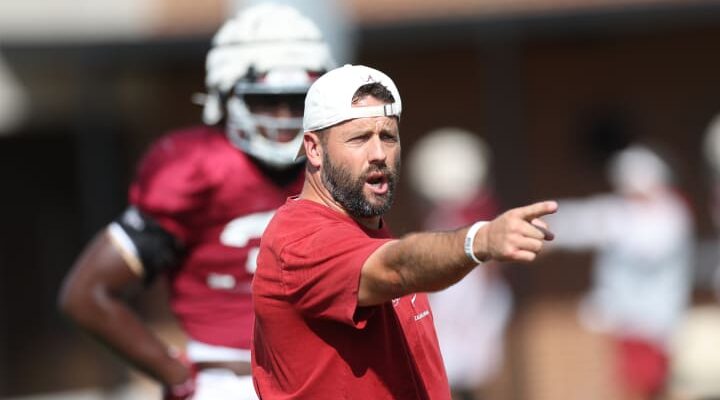Alabama Defensive Coordinator Kane Wommack Addresses Concerns Over Lack of Takeaways and Outlines Strategy for Creating More Turnovers in 2025
In the world of college football, creating turnovers is more than just a defensive statistic—it’s a momentum-shifting, game-defining skill that often separates good defenses from great ones. For Alabama defensive coordinator Kane Wommack, the standard is clear: the Crimson Tide defense must consistently generate takeaways if it wants to dominate in the SEC and contend for a national championship. Two weeks into fall camp, however, questions have surfaced about whether the defense is producing enough of those game-changing plays.
Wommack, known for his aggressive schemes and ability to develop disciplined, high-IQ defenders, addressed the issue head-on after a recent practice. “Of course we want more takeaways,” he said. “Turnovers create energy, set our offense up with short fields, and break an opponent’s confidence. But it’s also about creating those opportunities in the right way—through sound technique and disciplined play—not by gambling and giving up big plays.”
Through the early stages of camp, Alabama’s defense has excelled in limiting explosive plays and maintaining gap integrity. The pass rush has been steady, and the secondary has shown improved communication. But the interception and fumble recovery numbers haven’t matched the coaching staff’s internal goals. Wommack made it clear that while he’s not sounding the alarm, he expects those numbers to rise as camp continues.
Part of the challenge, he explained, is the nature of fall camp itself. Practices are scripted to give the offense and defense equal opportunities to work on specific situations, which can sometimes limit the chances for live-ball turnovers. Quarterbacks are also protected in practice, meaning strip-sack scenarios that might result in fumbles during games are often blown dead before defenders can finish the play.
Still, Wommack isn’t content to chalk it up to practice structure. He has emphasized ball awareness in every defensive meeting, showing film cut-ups of missed takeaway opportunities and walking players through the exact techniques needed to finish the play. Whether it’s a cornerback high-pointing a pass at its apex, a linebacker punching the ball free at the point of contact, or a defensive lineman ripping through a blocker to collapse the pocket, every position group has its role in the turnover equation.
Veteran leaders on the defense have embraced the challenge. Linebacker Deontae Lawson noted that takeaways often come from effort plays—pursuit from the backside, gang tackling, and stripping the ball when the opponent least expects it. “It’s about mindset,” Lawson said. “If you expect the ball to come out every time you hit someone, you start playing faster and more aggressively.”
In the secondary, cornerbacks like Kool-Aid McKinstry and freshman standout Jaylen Mbakwe have been tasked with improving ball skills. The defensive backs have spent extra time on drills that force them to track the ball in the air while maintaining tight coverage. Safeties like Caleb Downs are working on timing their breaks on the ball, a skill that can turn a pass breakup into an interception.
Wommack also pointed to the importance of situational awareness. Turnovers often occur in high-pressure moments—third-and-long, red-zone stands, or late-game drives where the offense is desperate. Teaching defenders to anticipate those situations and recognize when an offense is vulnerable is a key part of the preparation process.
While fans and analysts often use takeaway numbers as a barometer for defensive success, Wommack sees them as part of a bigger picture. “We’re building a defense that can dominate in every phase,” he said. “If we keep playing disciplined, fast, and physical, the takeaways will come. But I also don’t want guys chasing turnovers in a way that costs us on the back end.”
The coordinator’s confidence comes from history. In his previous stops, Wommack’s defenses have consistently improved in turnover margin as the season progressed. Early struggles have often given way to midseason surges once players fully grasp the nuances of his system. That trend gives reason to believe that Alabama’s current numbers may simply be a product of the learning curve.
For now, the emphasis remains on technique, effort, and trust in the process. Wommack’s message to his players is simple: keep doing your job, play with relentless energy, and when the opportunity for a takeaway presents itself, seize it. If the Crimson Tide can combine their already stout defensive structure with a spike in turnovers, they won’t just be stopping opponents—they’ll be flipping games in their favor.
With the season opener on the horizon, Alabama’s defense knows it must be opportunistic to reach its lofty goals. And if Wommack’s track record is any indication, the takeaways will arrive—right on time, and in bunches.



